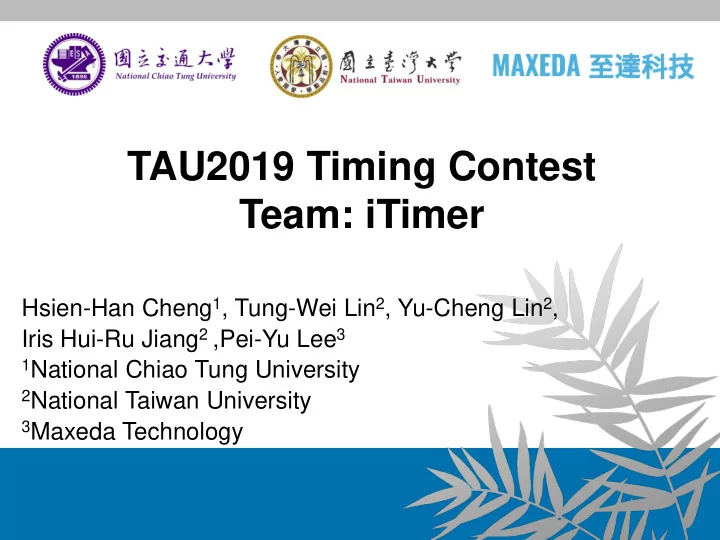

TAU2019 Timing Contest Team: iTimer Hsien-Han Cheng 1 , Tung-Wei Lin 2 , Yu-Cheng Lin 2 , Iris Hui-Ru Jiang 2 ,Pei-Yu Lee 3 1 National Chiao Tung University 2 National Taiwan University 3 Maxeda Technology
Problem Formulation The Design Optimization Problem – Given Initial circuit netlist (.v) RC parasitics (.spef) Timing and design constraint file (.sdc) Multiple corner liberties (.lib), – Constraints No hold time violations across multiple corners No slew or cap violations across multiple corners – Objectives Maximize working frequency Minimize leakage Minimize area Minimize runtime Minimize memory 2
Challenges Gate sizing is NP-hard Multi-corner timing optimization is first considered Unbalanced clock tree complicates timing optimization W. Ning, "Strongly NP-Hard Discrete Gate-Sizing Problems", TCAD , vol. 13, no. 8, pp. 1045-1051, 1994. 3
Algorithm Flow 4
Worst Corner Identification The corner which has the slowest cells bounds the highest operating frequency The corner with the most total negative slack (TNS) is worst corner All subsequent optimization steps focus on timing from worst corner except hold time fixing 5
Max Cap/Slew Fixing Gate upsizing or buffer insertion can solve the violations Apply the following procedures sequentially unless the violation is fixed – Upsize C – Downsize the fanout cell of C – Insert buffer after C – Insert buffer before the fanout cell of C Perform cap/slew violation fixing in BFS order first and then reverse BFS order 6
Clock Tree Optimization CLK Buffer Removal – Remove clock buffers as many as possible in this stage – Can insert buffers later without inducing too much area overhead CLK Buffer Insertion for Hold Time Fixing – Fix hold time violations in three ways Clock tree split point buffer insertion Clock tree leaf point buffer insertion Data path buffer insertion 7
Setup Time Optimization Gate Upsizing – Sensitivities of gates on top k critical paths are recorded – The top n gates with the highest sensitivities (defined by Equation (1)) are upsized Useful Skew – Is applied on the most critical path – With attention on positive hold time slacks 8
Leakage/Area Recovery Segment Dependency Graph (SDG) can estimate the propagation of setup slacks after downsizing With the global view provided by SDG, we can identify the segments that are less critical and downsize them without harming worst setup slacks 9
Legalization Apply Max Cap/Slew Fixing and Multi-corner Hold Time Fixing Multi-corner Hold Time Fixing – Iterate all corners – Insert buffers only on data path 10
Experiment Results (1/2) Platform: Intel Xeon 2.6GHz Linux Workstation with 197GB memory and 32 CPUs w.r.t. zero clock period |WNS (Setup)| = longest path delay = 1/frequency 11
Experiment Results (2/2) usb_function: enormous clock skew Clk Tree Opt reduces |WNS (setup)| by 30% – Origin goal is to solve hold time violation – The harm of an imbalanced clock tree 12
Conclusion and Future Work On average, our flow can decrease worst setup slack by around 56%, leakage by 48% and area by 39%. Experiment results show that our proposed algorithm is imperative and can gain notable slack improvement in each stage Our future work includes further shortening the runtime and improving the solution quality. 13
Thank you! 14
Recommend
More recommend